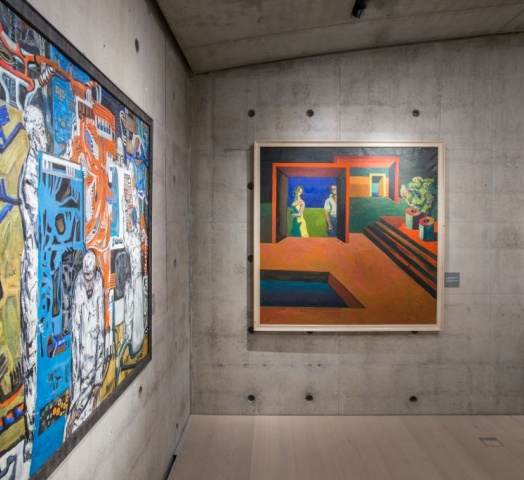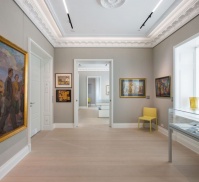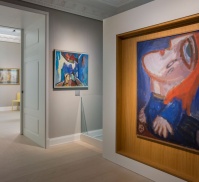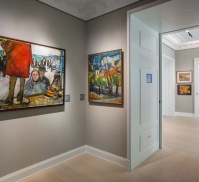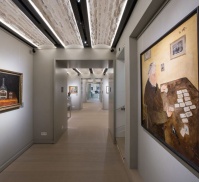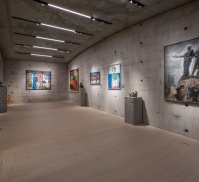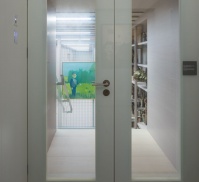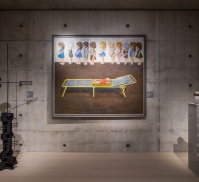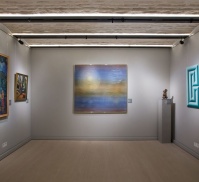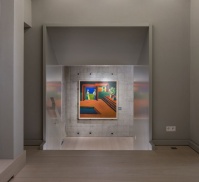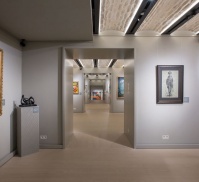Free and Unfree. Lithuanian Art between 1945 and 1990
In its fourth exhibition, the Lithuanian Art Centre Tartle showcases part of its collection representing the tendencies in artistic life in Soviet-occupied Lithuania, and features of the work by artists who fled to the West. In Lithuania, the period was distinguished by the efforts by artists to adapt or find a way around the requirements the Soviet authorities placed on art; and in the work by émigré artists of the time, creative freedom was combined with the aim to preserve Lithuanian traditions.
The works on display are by artists who are traditionally associated with the golden age of Lithuanian art in the second half of the 20th century. They include Silvestras Džiaukštas, Vincentas Gečas, Antanas Gudaitis, Vincas Kisarauskas, Leopoldas Surgailis, Stasys Ušinskas and Kazė Zimblytė. Representatives of émigré and Litvak art include Arbit Blatas, Pranas Domšaitis, Jacques Lipchitz, Jonas Rimša, Elena Urbaitytė-Urbaitis, Kazys Varnelis and Kazimieras Žoromskis. The paintings, sculptures, graphic works and glass reflect not only the aesthetic side of art, but also aspects of the cultural and social contexts of this complex period.
The first rooms in the gallery focus on the influence of the social situation and the political changes on the artistic language and stylistics of Soviet-period art. They emphasise the role of official propaganda, which demanded that art be ‘national in form and socialist in content’, and include images of collective farm workers having lunch, the Church of St Casimir without its cross, a concert given by the Lietuva song and dance ensemble, and variations on the theme of the popular folk tale ‘Eglė, Queen of the Serpents’. The exhibition draws attention to the change in artistic style: from pure Socialist Realism to the search for an individual style, and the process of the modernisation of art that started in the period of the political ‘thaw’.
Other rooms display works that illustrate tendencies in the creative work of artists who fled from Lithuania: some adapted to the prevailing local artistic traditions, in an attempt to gain a foothold in their new country, others preserved their Lithuanian identity, and some managed to both preserve their identity and adapt to new ideas. The display highlights the phenomenon of the Freiburg School of Arts and Crafts in the postwar years, the cultural activities of émigré communities, and the individual choices of artists, and also looks at certain features of the work of Litvak artists.
The exhibition invites visitors to view the multi-faceted micro-narratives and macro-history of the second half of the 20th century through art. It includes 80 paintings, works of graphic art, sculptures, glass, ceramics and prints from the Tartle collection. One painting has also been lent for the exhibition by the Mo Museum.
Dovilė Barcytė, Ieva Burbaitė, art historians and exhibition curators

In its fourth exhibition, the Lithuanian Art Centre Tartle showcases part of its collection representing the tendencies in artistic life in Soviet-occupied Lithuania, and features of the work by artists who fled to the West. In Lithuania, the period was distinguished by the efforts by artists to adapt or find a way around the requirements the Soviet authorities placed on art; and in the work by émigré artists of the time, creative freedom was combined with the aim to preserve Lithuanian traditions.
The works on display are by artists who are traditionally associated with the golden age of Lithuanian art in the second half of the 20th century. They include Silvestras Džiaukštas, Vincentas Gečas, Antanas Gudaitis, Vincas Kisarauskas, Leopoldas Surgailis, Stasys Ušinskas and Kazė Zimblytė. Representatives of émigré and Litvak art include Arbit Blatas, Pranas Domšaitis, Jacques Lipchitz, Jonas Rimša, Elena Urbaitytė-Urbaitis, Kazys Varnelis and Kazimieras Žoromskis. The paintings, sculptures, graphic works and glass reflect not only the aesthetic side of art, but also aspects of the cultural and social contexts of this complex period.
The first rooms in the gallery focus on the influence of the social situation and the political changes on the artistic language and stylistics of Soviet-period art. They emphasise the role of official propaganda, which demanded that art be ‘national in form and socialist in content’, and include images of collective farm workers having lunch, the Church of St Casimir without its cross, a concert given by the Lietuva song and dance ensemble, and variations on the theme of the popular folk tale ‘Eglė, Queen of the Serpents’. The exhibition draws attention to the change in artistic style: from pure Socialist Realism to the search for an individual style, and the process of the modernisation of art that started in the period of the political ‘thaw’.
Other rooms display works that illustrate tendencies in the creative work of artists who fled from Lithuania: some adapted to the prevailing local artistic traditions, in an attempt to gain a foothold in their new country, others preserved their Lithuanian identity, and some managed to both preserve their identity and adapt to new ideas. The display highlights the phenomenon of the Freiburg School of Arts and Crafts in the postwar years, the cultural activities of émigré communities, and the individual choices of artists, and also looks at certain features of the work of Litvak artists.
The exhibition invites visitors to view the multi-faceted micro-narratives and macro-history of the second half of the 20th century through art. It includes 80 paintings, works of graphic art, sculptures, glass, ceramics and prints from the Tartle collection. One painting has also been lent for the exhibition by the Mo Museum.
Dovilė Barcytė, Ieva Burbaitė, art historians and exhibition curators






